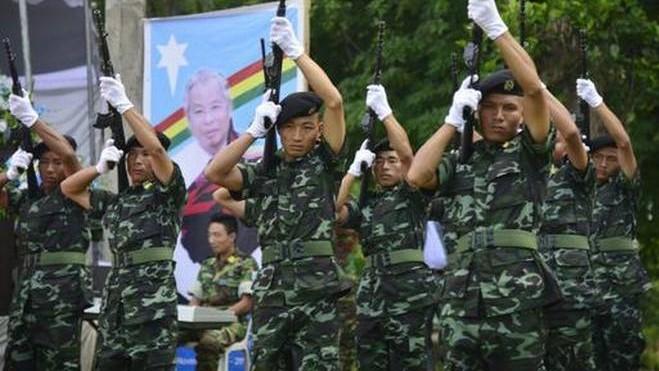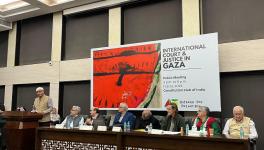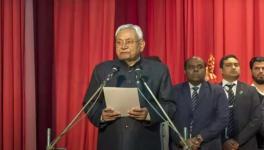Naga Movement: Caught Between Border Infrastructure and Military Operations

Representational image. | Image Courtesy: The Hindu
Events along the India-Myanmar border that have spanned since January could lead one to believe that the sun is setting on some of the oldest armed political organisations in Asia. However, the build up to this moment was rather ordinary, India provided development aid and lines of credit to Myanmar, particularly towards improving accessibility in the Chin State and the Sagaing region along the Indo-Myanmar border. With the final Indo-Naga agreement in a limbo, these moves may be aimed to prevent any future havens for disgruntled and de-mobilised Naga workers.
Infrastructural and Developmental Aid
According to the website of the Indian Embassy in Yangon, there have been two major road projects close to the India-Myanmar border. The Tamu Kale Kalewa (TKK) road was initiated in 1997; the year a ceasefire was agreed upon by India and the National Socialist Council of Nagaland (Isak Muivah) (NSCN(IM)). The $27 million project for 160 km of road was completed in 2001. The road is in the process of being upgraded at a cost of $60 million, where India has committed to build 71 bridges and approach roads.
Another project mentioned on the Embassy website is the Rihkhawdar-Tedim road. Estimated to cost $150 million for 80 km of road, the project would connect Rihkhawdar in Myanmar which is close to Zokhawthar in Mizoram with Tedim in the Chin State. Tedim road further connects up north to Khenman along the border with the Churachandpur district in Manipur.
In May 2012, India and Myanmar signed a memorandum of understanding (MoU) for border development. Then, in November 2018, the MoU came to fruition with a pledge of $25 million spread over five years to build schools, roads and bridges in the Chin State and the Naga Self-Administered Zone (NSAZ). According to the Indian Embassy website, so far five roads and bridges and three schools have been built in the Chin State. While five roads and bridges and eight schools have been built in the NSAZ.
Another project aimed at the NSAZ is to introduce cardamom as a cash crop. This project is estimated at $0.1 million. Further, a line of credit of $7 million has been extended to boost telecommunications connectivity in Yangon as well as laying an optic fibre line between Moreh and Mandalay. This project was completed between 2003 and 2004.
Framework Agreement
On August 3, 2015 the Indian government signed with much fanfare a ‘historic’ framework agreement with the NSCN(IM). Later, the agreement was extended to include the Working Committee (WC) of six Naga National Political Groups (NNPG). In January this year, the Khango Konyak faction of the National Socialist Council of Nagaland (Khaplang) (NSCN(K)) crossed the border and became a party to the agreement.
However, what ought to be pointed out is that all the Naga groups and factions that are party to the agreement comprise Nagas who were born in the Indian claimed territory. Since the split in the NSCN(K) in August last year, there are few Indian- born second-rung leaders in the organisation. This has made matters easier for both the Government of India as well as of Myanmar to force the Myanmar-born Nagas to abandon all ties with armed political groups from the Northeast.
On January 29 this year, the Tatmadaw (the armed forces of Myanmar) occupied the NSCN(K) headquarters in Taga. Both sides had varying reports. The Tatmadaw claimed that they had defeated the armed cadres of the group and occupied the headquarters, whereas the NSCN(K) maintained that they had retreated upon the advance of the Myanmar army. What is clear is that in the process, 24 members of Assam and Manipur-based armed political groups were apprehended by the Tatmadaw. On May 15, the Hkamti District Court in Sagaing sentenced the captured cadres to two years in prison. The next day the operations against the NSCN(K) and the Northeastern organisations officially commenced.
Operation Sunshine
The Indian Express reported on June 16 that India and Myanmar had launched joint operations against the armed political groups and their camps along the India-Myanmar border. The report stated that the military action named ‘Operation Sunshine’ had taken place in two phases. The first phase was between February 22 to 26 and targeted the Arakan Army (AA) camps that had been established in Mizoram. The AA is a fairly recent addition to Myanmar’s multitude of ethnic insurgencies. However, rather than focusing on the establishment of ethnic supremacy in a particular zone -- the Rakhine State in this case -- the AA seeks to rebuild the former Arakan Kingdom that was invaded and appended to then Burma in 1784. The focus of the AA’s activities is aimed towards ‘liberating’ the Arakan --- they view the term Rakhine as a pejorative -- the bulk of the fighting has occurred in the Chin State and northern Rakhine bordering Mizoram.
As of December 2017, reports have indicated that Chin refugees ,who are ethnically related to Mizos, Zomis and Kukis, entered Mizoram as a result of the fighting between AA and Tatmadaw. On February 18, the Assam Tribune had reported that two companies -- roughly 180 soldiers -- of the Indian Army had been deployed in Mizoram to seal the border. The Irrawaddy reported on February 18 that the AA had confirmed the presence of around 500 Indian troops along the border. It is in this backdrop that Myanmar’s reciprocation regarding the Northeastern armed political groups taking shelter in its territory could be considered realistic.
Operation Sunshine 2 took place between May 16 and June 8. The Indian Express reported that around 70 to 80 cadres of various Assam and Manipur groups as well as of the NSCN(K) had been apprehended and handed over to the local police authorities. The report also mentioned that the Myanmar army would stay in the region for another three months to deny the organisations an opportunity to regroup during the monsoon. However, the same day an Indian Express report appeared saying that the Tatmadaw denied that any joint military operations had taken place. The Irrawaddy also reported that a member of the NSCN(K) had confirmed to them that no joint operation had taken place.
Unlike the 2015 cross-border raid which led to a round of chest-thumping, these operations seem to have been low key. However, like the previous raids, the two sides allegedly involved have taken contradictory stands on whether they occurred and who was involved. This invariably would lead one to presume that the contradictory stands have been taken keeping domestic audiences in mind.
For India, the show that nobody who is fighting against the Indian state is safe is the objective. Whereas for Myanmar, it is about showing that their territorial integrity can never be threatened. However, the question remains as to why the NSCN(K) has indirectly supported the Tatmadaw’s version. One likely explanation is for their captured cardres to receive a lenient sentence.
Extraterritorial Ambitions for Nagalim
The government Myanmar has been trying to force the NSCN(K) to sign the Nationwide Ceasefire Agreement (NCA). The NSCN(K) maintains that the Nagas were never a party to the first Panglong Agreement with Daw Aung San -- the father of Aung San Su Kyi. Hence, they view the NCA as merely a reiteration of that first agreement for self-autonomous zones. In 2012, the NSCN(K) had entered into a ceasefire agreement with the government of Myanmar. However, they have consistently refused to sign the NCA. The issue for both the government of Myanmar as well as the NSCN(K) is that the Naga group has political ambitions beyond Myanmar’s territory. Hence, the Indian government’s strategy of dividing the Naga movement on the basis of the international boundary is something the Tatmadaw can get on board with.
However, following the military action in May, the NSCN(IM) too had something to say. On May 19, the organisation issued a press statement from Camp Hebron in Dimapur condemning the Tatmadaw’s offensive on the villages of Hoyat and Laonyu. This could indicate that despite being the initial party to the framework agreement with the government of India, the NSCN(IM) has not completely abandoned its extraterritorial political ambitions.
On June 13, the Nagaland Post reported that the NSCN(K) has ordered retaliatory strikes for the operations it was subject to. If true, this would indicate that the organisation still has sufficient strength to fight. Thus, Operation Sunshine 2 may not have been much of a success. In fact, barely a week since Operation Sunshine 2 commenced, the NSCN(K) had attacked an Assam Rifles convoy in the Mon region of Nagaland. Two soldiers were killed and four wounded in the attack. It would thus appear that though both India and Myanmar are using military tools to force a political settlement, the big challenge is confronting the dream of Nagalim. However, by improving border infrastructure in terms of roads and telecommunications, there appears to be a push towards ensuring that the government of Myanmar can keep a sterner eye on the expression of the dream.
Get the latest reports & analysis with people's perspective on Protests, movements & deep analytical videos, discussions of the current affairs in your Telegram app. Subscribe to NewsClick's Telegram channel & get Real-Time updates on stories, as they get published on our website.
























